On Monday night observers in parts of Mexico, the western U.S., and central Canada may see the occultation of a lifetime when a tiny asteroid momentarily blots out the night sky's brightest star.
UPDATE (Feb. 15, 2019): Path shift! See end of article.
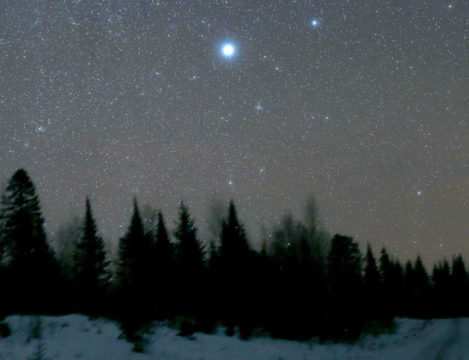
Bob King
Can a 7-kilometer-wide asteroid make Sirius disappear? You bet it can. That just might happen on Monday night, February 18th. That evening around 10:30 p.m. MST (5:30 UT February 19th), there's a good probability that the 17th-magnitude 4388 Jürgenstock will occult the sky's brightest star for up to 1.8 seconds. Visibility stretches along a narrow path from the southern tip of Baja California to the Las Cruces–El Paso region, up through the Great Plains, and north to the Winnipeg area. While only a limited number of people may see this event, anytime Sirius disappears, however briefly, it's news!
The reason for the uncertainly lies in not having a precise position nailed down for Sirius. The recent Gaia Mission plotted a billion star positions to an accuracy of less than 0.0001 arcsecond, ideal for dead-on occultation predictions. But Sirius couldn't be measured because its singular brilliance oversaturated Gaia's detector.
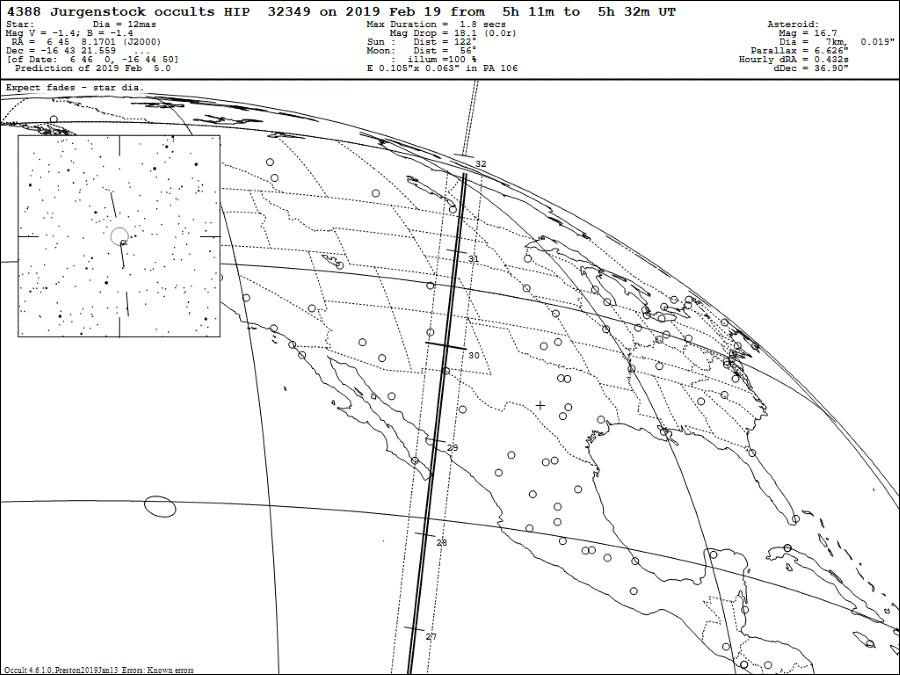
Occult 4.6
Ironically, while Gaia couldn't pinpoint Sirius's position, astronomers examining the sky around the star discovered a hitherto unknown, massive star cluster hidden in its glare. Gaia 1, located 10′ (arcminutes) east of the Sirius and 15,000 light-years away, has eluded skywatchers for centuries! Even the 1991 Hipparcos mission struggled with Sirius, but despite some uncertainty it produced reasonably good data.
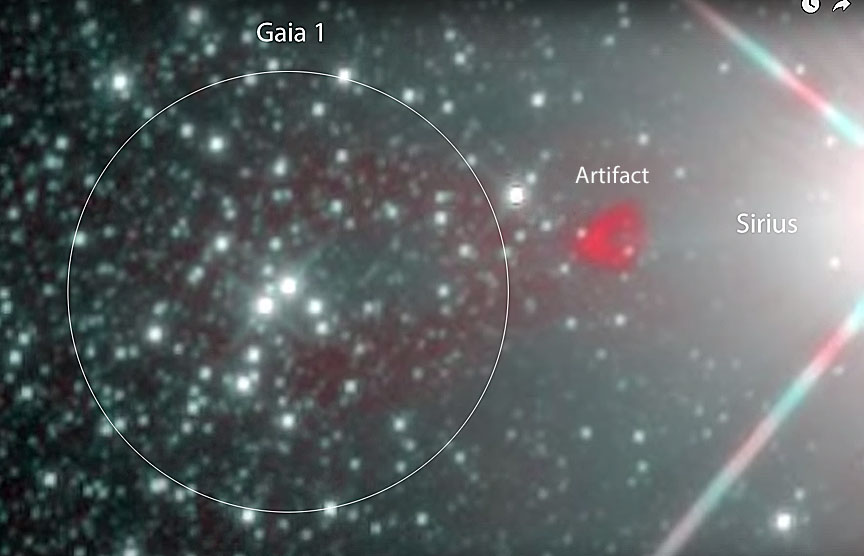
ESA / Gaia
Assuming the occultation occurs, the asteroid's tiny size (0.007″) is only slightly larger than the disk of Sirius (0.0060″). According to David Dunham with the International Occultation Timing Association (IOTA), the star may completely disappear at the centerline for a mere 0.2 seconds of the 1.8-second-long event. Observers will see Sirius fade, blank out only momentarily, then brighten to full brilliance. Since Jürgenstock is likely to have an irregular shape and could be a little larger or smaller than predicted, there's a chance that Sirius might blink-out for longer or shorter than expected, or fail to completely disappear.
There's also a bit of fuzziness about the asteroid's position, which might alter the timing and path slightly. Planned observations by JPL's Table Mountain Observatory before Monday (weather permitting) will tighten up those parameters. If there are updates or changes, I will post them here ASAP and make a note at the top of the blog. Be sure to check back if you're in or near the path.
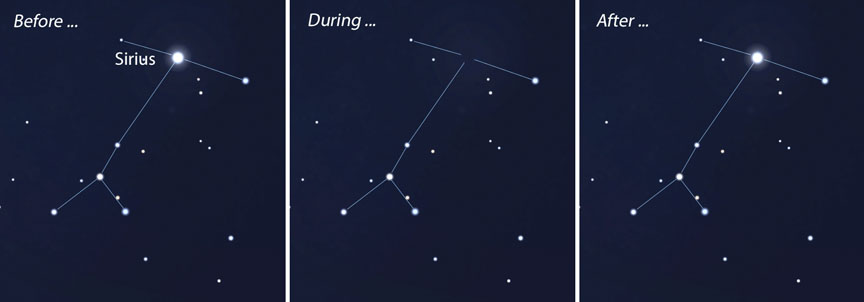
Stellarium
The Moon will be nearly full Monday evening with Sirius well placed in the southwestern sky at the time of the occultation. Observers are encouraged to make timings of the event to help get a fix on Sirius as well as glean details about the asteroid and its orbit. Sirius can exhibit violent twinkling — let's hope for serene air lest atmospheric turbulence mask what could be the most amazing occultation in a long time.
Dunham has lots of extra information including sectional maps and times for specific cities. Check these links for more details:
- General information about the occultation
- Interactive Google map
- Sectional "static maps" for easy reference
- Steve Preston's asteroid occultation primer
Coincidentally, a second occultation occurs earlier on Monday morning, February 18th, just after 12:30 UT (6:30 a.m. CST) when the 37-kilometer-wide asteroid 396 Aeolia covers 4.2-magnitude Chi (χ) Virginis for about 11 seconds. Chi is located 11° west of Spica; the path crosses southern Texas and northern Mexico. Click here for details.
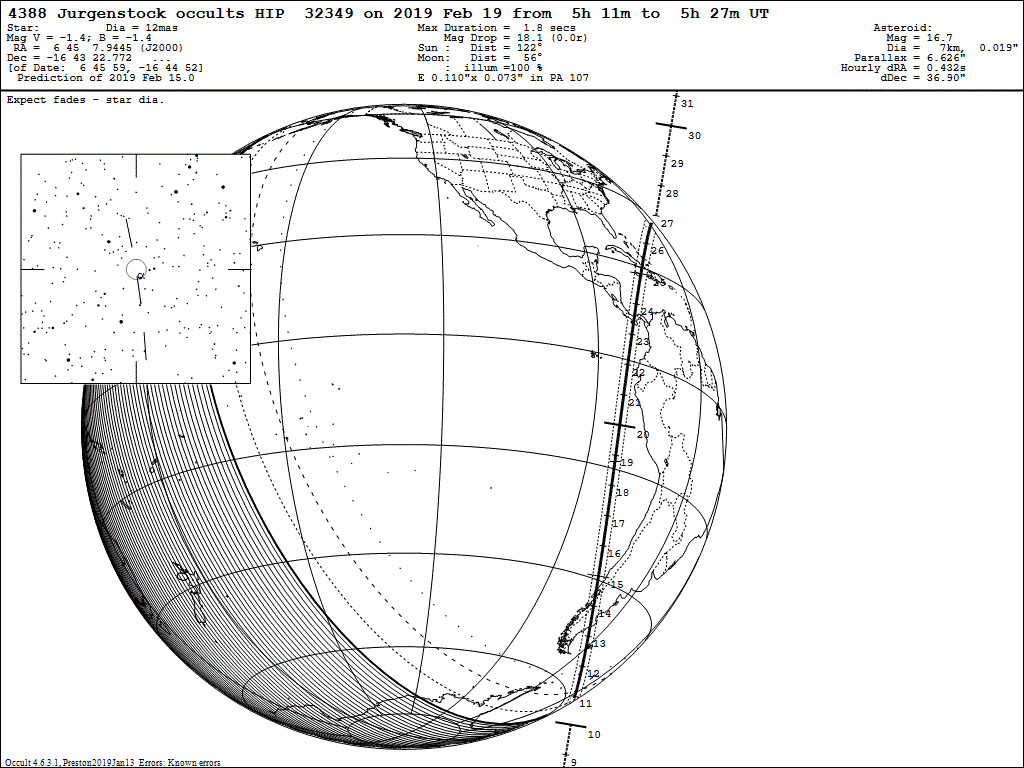
Occult 4.6
UPDATE (Feb. 15, 2019): New information from the IOTA group that takes into account the offset of Sirius A from the center of mass of the Sirius A-B system moves the occultation path substantially to the east. It's now predicted to cross southern Argentina, southern Chile, Central America and the Caribbean. For more details, click here and here.
 15
15









Comments
Larry McNish
February 13, 2019 at 8:09 pm
I don't know why it took so long to discover that Gaia 1 cluster beside Sirius. It popped right out at me when I took an image of Sirius without an occulting mask back in 2017 and then read about it very shortly thereafter.
Unprocessed original jpg is at:
https://grumpyoldastronomer.com/images/McNish_Sirius_DSC00115.jpg
Smaller, processed and annotated image at:
https://grumpyoldastronomer.com/images/McNish_Sirius_and_Gaia1_annotated_DSC00115.png
You must be logged in to post a comment.
Bob KingPost Author
February 15, 2019 at 12:56 pm
Thanks for sharing your photos, Larry. It almost seems as though it might be possible to see the cluster visually now that we know it's there. I plan to try at the next good opportunity.
You must be logged in to post a comment.
Rod
February 15, 2019 at 8:57 am
FYI. Yesterday there were a number of comments posted for this report but apparently a web server update erased them. I noticed the same on weekly sky report too. No big deal though.
You must be logged in to post a comment.
Monica Young
February 15, 2019 at 9:54 am
We experienced a website glitch yesterday and while our development team was able to restore most of the content, any comments posted through the day yesterday were erased. We're very sorry for the inconvenience!
You must be logged in to post a comment.
John Follower
February 16, 2019 at 10:50 pm
I see that even close to the occurrence, models are still trying to predict the correct path and now predictions have moved it in the map. Since the asteroid has been tracked more precisely, if viewers can pinpoint the exact moment of the occultation, it will finally set Siriu's precise position for good.
You must be logged in to post a comment.
Bob KingPost Author
February 17, 2019 at 3:12 pm
Hi John,
Yes, that will help enormously.
You must be logged in to post a comment.
John Van Allen
February 17, 2019 at 12:17 pm
My observing station is located in Santo Domingo. Whould it be worthwhile for me to observe or am I too far East. I'm at 18.463055N by 69.905805W
Regards
John Van Allen
You must be logged in to post a comment.
Bob KingPost Author
February 17, 2019 at 3:27 pm
Hi John,
According to the map it looks like you're about 250 kilometers (as the crow flies) too far east, so an occultation is unlikely. But I know if it were me, I'd set up and observe just in case. It would only take an additional slight shift of the path to bring it over your telescope, though none is expected as of this moment.
You must be logged in to post a comment.
John Van Allen
February 17, 2019 at 6:13 pm
Thanks and we will have a look,
You must be logged in to post a comment.
Dan
February 22, 2019 at 2:11 pm
Are there any reported observations?
You must be logged in to post a comment.
Bob KingPost Author
February 22, 2019 at 2:13 pm
Hi Dan,
I'm crossing my fingers there were. I expected to hear by now but nothing, so I'll contact D. Dunham and see if he's heard of any. Like you I'm eager to know.
You must be logged in to post a comment.
Dan
February 22, 2019 at 4:03 pm
I observed visually from my home in Wisconsin. I would have been tempted to drive to South Dakota to see this as it interested me. Alas, I have a day job. Then the predicted area changed so I was glad I didn't make the drive! I actually saw what could have been a very brief occultation event at 11:17PM CST but there were high clouds and bad seeing so I cannot be sure it wasn't just the weather. It was not quite the predicted time or location but I thought there could be a possibility of an unknown nearby body or moon.
You must be logged in to post a comment.
Bob KingPost Author
February 23, 2019 at 12:49 pm
Hi Dan,
Thanks for sharing your report. I checked with occultation expert David Dunham yesterday and thus far, he's heard of no positive reports and very few negatives.
You must be logged in to post a comment.
kirszenb
March 3, 2019 at 5:03 pm
Hi. Did anyone actually see the occultation of Sirius by the asteroid on Feb 18th?
If so, would you please list here the URL or the article title for that observation so we can read it?
kind regards,
John
You must be logged in to post a comment.
Bob KingPost Author
March 4, 2019 at 12:34 am
Kirszenb,
I've asked about but have heard of no observations yet. Anyone else?
You must be logged in to post a comment.
You must be logged in to post a comment.